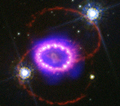Speaker
Mr
itay Rabinak
(Weizmann institute of science)
Description
We derive a simple approximate model describing the early, up to a few days,
UV/optical supernova emission, which is produced by the expansion of the
outer hundredth solar mass of the shock-heated envelope, following the shock
breakout and preceding the optical emission driven by radioactive decay. Our
model includes an approximate description of the time dependence of the
opacity (due mainly to recombination), and of the deviation of the emitted
spectrum from a black body spectrum. For He envelopes, neglecting the effect
of recombination may lead to an underestimate of the luminosity by more than
an order of magnitude. We also show that the relative extinction at different
wavelengths may be inferred from the light-curves at these wave-lengths,
removing the uncertainty in the estimate of progenitor radius due to reddening
(but not the uncertainty in E/M due to uncertainty in absolute extinction). For
core collapse SN, the characteristics of the early UV/O emission constrain the
radius of the progenitor star, its envelope composition, and the ratio of the
ejecta energy to its mass, E/M. For SN Ia, the characteristics of the emission
may allow one to distinguish between a pure deflagration explosion and a
delayed detonation (DDT) explosion, and to constrain the detonation and
deflagration velocities for DDT explosion. The early UV/O observations of the
type Ib SN2008D and of the type IIp SNLS-04D2dc are consistent with our
model predictions. For SN2008D we find progenitor radius to be approximately
10^11 cm, and an indication that the He envelope contains a significant C/O
fraction.
Primary author
Mr
itay Rabinak
(Weizmann institute of science)

